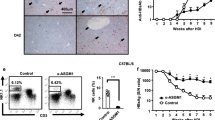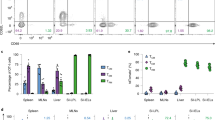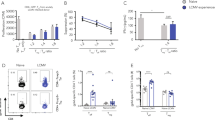Abstract
Innate lymphoid cells (ILCs) are tissue-resident sentinels that are essential for early host protection from pathogens at initial sites of infection. However, whether pathogen-derived antigens directly modulate the responses of tissue-resident ILCs has remained unclear. In the present study, it was found that liver-resident type 1 ILCs (ILC1s) expanded locally and persisted after the resolution of infection with mouse cytomegalovirus (MCMV). ILC1s acquired stable transcriptional, epigenetic and phenotypic changes a month after the resolution of MCMV infection, and showed an enhanced protective effector response to secondary challenge with MCMV consistent with a memory lymphocyte response. Memory ILC1 responses were dependent on the MCMV-encoded glycoprotein m12, and were independent of bystander activation by proinflammatory cytokines after heterologous infection. Thus, liver ILC1s acquire adaptive features in an MCMV-specific manner.
This is a preview of subscription content, access via your institution
Access options
Access Nature and 54 other Nature Portfolio journals
Get Nature+, our best-value online-access subscription
$29.99 / 30 days
cancel any time
Subscribe to this journal
Receive 12 print issues and online access
$209.00 per year
only $17.42 per issue
Buy this article
- Purchase on Springer Link
- Instant access to full article PDF
Prices may be subject to local taxes which are calculated during checkout






Similar content being viewed by others
Data availability
The RNA-seq and ATAC-seq data are deposited in Gene Expression Omnibus database under the accession number GSE128906. The data that support the findings of this study are available from the corresponding author upon request.
References
Henning, A. N., Roychoudhuri, R. & Restifo, N. P. Epigenetic control of CD8+ T cell differentiation. Nat. Rev. Immunol. 18, 340–356 (2018).
Youngblood, B., Hale, J. S. & Ahmed, R. T-cell memory differentiation: insights from transcriptional signatures and epigenetics. Immunology 139, 277–284 (2013).
Bantug, G. R., Galluzzi, L., Kroemer, G. & Hess, C. The spectrum of T cell metabolism in health and disease. Nat. Rev. Immunol. 18, 19–34 (2018).
Chang, J. T., Wherry, E. J. & Goldrath, A. W. Molecular regulation of effector and memory T cell differentiation. Nat. Immunol. 15, 1104–1115 (2014).
Schenkel, J. M. & Masopust, D. Tissue-resident memory T cells. Immunity 41, 886–897 (2014).
O’Sullivan, T. E., Sun, J. C. & Lanier, L. L. Natural killer cell memory. Immunity 43, 634–645 (2015).
Netea, M. G. et al. Trained immunity: a program of innate immune memory in health and disease. Science 352, aaf1098 (2016).
Martinez-Gonzalez, I. et al. Allergen-experienced group 2 innate lymphoid cells acquire memory-like properties and enhance allergic lung inflammation. Immunity 45, 198–208 (2016).
Artis, D. & Spits, H. The biology of innate lymphoid cells. Nature 517, 293–301 (2015).
Serafini, N., Vosshenrich, C. A. & Di Santo, J. P. Transcriptional regulation of innate lymphoid cell fate. Nat. Rev. Immunol. 15, 415–428 (2015).
Kotas, M. E. & Locksley, R. M. Why innate lymphoid cells? Immunity 48, 1081–1090 (2018).
Weizman, O. E. et al. ILC1 confer early host protection at initial sites of viral infection. Cell 171, 795–808 e712 (2017).
Klose, C. S. N. et al. Differentiation of type 1 ILCs from a common progenitor to all helper-like innate lymphoid cell lineages. Cell 157, 340–356 (2014).
Abt, M. C. et al. Innate immune defenses mediated by two ILC subsets are critical for protection against acute Clostridium difficile infection. Cell Host Microbe 18, 27–37 (2015).
Boulenouar, S. et al. Adipose type one innate lymphoid cells regulate macrophage homeostasis through targeted cytotoxicity. Immunity 46, 273–286 (2017).
Gasteiger, G., Fan, X., Dikiy, S., Lee, S. Y. & Rudensky, A. Y. Tissue residency of innate lymphoid cells in lymphoid and nonlymphoid organs. Science 350, 981–985 (2015).
Moro, K. et al. Interferon and IL-27 antagonize the function of group 2 innate lymphoid cells and type 2 innate immune responses. Nat. Immunol. 17, 76–86 (2016).
Sun, J. C., Beilke, J. N. & Lanier, L. L. Adaptive immune features of natural killer cells. Nature 457, 557–561 (2009).
Sun, J. C. et al. Proinflammatory cytokine signaling required for the generation of natural killer cell memory. J. Exp. Med. 209, 947–954 (2012).
Beaulieu, A. M., Zawislak, C. L., Nakayama, T. & Sun, J. C. The transcription factor Zbtb32 controls the proliferative burst of virus-specific natural killer cells responding to infection. Nat. Immunol. 15, 546–553 (2014).
Zhou, J. et al. Liver-resident NK cells control antiviral activity of hepatic T cells via the PD-1-PD-L1 axis. Immunity 50, 403–417.e4 (2019).
Best, J. A. et al. Transcriptional insights into the CD8+ T cell response to infection and memory T cell formation. Nat. Immunol. 14, 404–412 (2013).
van der Veeken, J. et al. Memory of inflammation in regulatory T cells. Cell 166, 977–990 (2016).
Bradley, L. M., Haynes, L. & Swain, S. L. IL-7: maintaining T-cell memory and achieving homeostasis. Trends Immunol. 26, 172–176 (2005).
Raeber, M. E., Zurbuchen, Y., Impellizzieri, D. & Boyman, O. The role of cytokines in T-cell memory in health and disease. Immunol. Rev. 283, 176–193 (2018).
Freeman, B. E., Hammarlund, E., Raue, H. P. & Slifka, M. K. Regulation of innate CD8+ T-cell activation mediated by cytokines. Proc. Natl Acad. Sci. USA 109, 9971–9976 (2012).
Kambayashi, T., Assarsson, E., Lukacher, A. E., Ljunggren, H. G. & Jensen, P. E. Memory CD8+cells provide an early source of IFN-gamma. J. Immunol. 170, 2399–2408 (2003).
Bezman, N. A. et al. Molecular definition of the identity and activation of natural killer cells. Nat. Immunol. 13, 1000–1009 (2012).
Scott-Browne, J. P. et al. Dynamic changes in chromatin accessibility occur in CD8+ T cells responding to viral infection. Immunity 45, 1327–1340 (2016).
Lau, C. M. et al. Epigenetic control of innate and adaptive immune memory. Nat. Immunol. 19, 963–972 (2018).
Scharer, C. D., Bally, A. P., Gandham, B. & Boss, J. M. cutting edge: chromatin accessibility programs CD8 T cell memory. J. Immunol. 198, 2238–2243 (2017).
Mackay, L. K. et al. Hobit and Blimp1 instruct a universal transcriptional program of tissue residency in lymphocytes. Science 352, 459–463 (2016).
Aguilar, O. A. et al. A viral immunoevasin controls innate immunity by targeting the prototypical natural killer cell receptor family. Cell 169, 58–71 e14 (2017).
Sun, J. C. & Lanier, L. L. The natural selection of herpesviruses and virus-specific NK cell receptors. Viruses 1, 362 (2009).
Snyder, C. M. et al. Memory inflation during chronic viral infection is maintained by continuous production of short-lived, functional T cells. Immunity 29, 650–659 (2008).
Arase, H., Mocarski, E. S., Campbell, A. E., Hill, A. B. & Lanier, L. L. Direct recognition of cytomegalovirus by activating and inhibitory NK cell receptors. Science 296, 1323–1326 (2002).
O’Leary, J. G., Goodarzi, M., Drayton, D. L. & von Andrian, U. H. T cell- and B cell-independent adaptive immunity mediated by natural killer cells. Nat. Immunol. 7, 507–516 (2006).
Paust, S. et al. Critical role for the chemokine receptor CXCR6 in NK cell-mediated antigen-specific memory of haptens and viruses. Nat. Immunol. 11, 1127–1135 (2010).
Peng, H. et al. Liver-resident NK cells confer adaptive immunity in skin-contact inflammation. J. Clin. Invest. 123, 1444–1456 (2013).
Cooper, M. A. et al. Cytokine-induced memory-like natural killer cells. Proc. Natl Acad. Sci. USA 106, 1915–1919 (2009).
Quintin, J. et al. Candida albicans infection affords protection against reinfection via functional reprogramming of monocytes. Cell Host Microbe 12, 223–232 (2012).
Min-Oo, G. & Lanier, L. L. Cytomegalovirus generates long-lived antigen-specific NK cells with diminished bystander activation to heterologous infection. J. Exp. Med. 211, 2669–2680 (2014).
Liu, F., Song, Y. & Liu, D. Hydrodynamics-based transfection in animals by systemic administration of plasmid DNA. Gene Ther. 6, 1258–1266 (1999).
Tokuyama, M. et al. ERVmap analysis reveals genome-wide transcription of human endogenous retroviruses. Proc. Natl Acad. Sci. USA 115, 12565–12572 (2018).
Buenrostro, J. D., Giresi, P. G., Zaba, L. C., Chang, H. Y. & Greenleaf, W. J. Transposition of native chromatin for fast and sensitive epigenomic profiling of open chromatin, DNA-binding proteins and nucleosome position. Nat. Methods 10, 1213–1218 (2013).
Zhang, Y. et al. Model-based analysis of ChIP-Seq (MACS). Genome Biol. 9, R137 (2008).
Zigler, C. M. & Belin, T. R. The potential for bias in principal causal effect estimation when treatment received depends on a key covariate. Ann. Appl. Stat. 5, 1876–1892 (2011).
Acknowledgements
We thank members of the labs of T.E.O., C.S.L., J.R.C., A. Iwasaki and J.C.S. for helpful comments and discussions. We thank J. Reichel and S. Jonjic for reagents. E.S. was supported by the National Institutes of Health (NIH) Medical Scientist Training Program training grant (no. T32GM007205). N.M.A. was supported by a Medical Scientist Training Program grant from the National Institute of General Medical Sciences of the NIH (no. T32GM007739 to the Weill Cornell/Rockefeller/Sloan Kettering Tri-Institutional MD/PhD Program) and an F30 Predoctoral Fellowship from the National Institute of Allergy and Infectious Diseases of the NIH (no. F30 AI136239). J.C.S. was supported by the Ludwig Center for Cancer Immunotherapy, the Burroughs Wellcome Fund, the American Cancer Society and grants from the NIH (nos. AI100874, AI130043 and P30CA008748). T.E.O. was supported by the NIH (nos. P30DK063491 and AI145997).
Author information
Authors and Affiliations
Contributions
O.E.W. and T.E.O. designed the study. O.E.W., N.M.A., A.D.H., L.R. and T.E.O. performed the experiments. E.S., C.K. and C.S.L. performed RNA-seq and ATAC-seq bioinformatics analysis. J.R.C. and O.A.A. provided reagents. O.E.W., J.C.S. and T.E.O. wrote the manuscript.
Corresponding author
Ethics declarations
Competing interests
The authors declare no competing interests.
Additional information
Journal Peer Review Information: Ioana Visan was the primary editor on this article and managed its editorial process and peer review in collaboration with the rest of the editorial team.
Publisher’s note: Springer Nature remains neutral with regard to jurisdictional claims in published maps and institutional affiliations.
Integrated supplementary information
Supplementary Figure 1 Related to Figure 2. Phenotypic and functional stability of Liver ILC1 during MCMV challenge.
(a) Flow cytometry gating strategy for identifying Liver ILC1. (b) 4×104 liver ILC1 (Lin-NK1.1+ CD49b-CD200r1+CD11b-Ly49H-) were sort purified from CD45.1+ mice, adoptively transferred i.v. into Ly49H-deficient CD45.2+ WT hosts, and subsequently infected with MCMV. Histograms show indicated cell surface markers on liver ILC1 and mNK cells from uninfected WT mice and adoptively transferred liver ILC1 recovered 7 days PI. Data are representative of 3 independent experiments with n=3 mice per group.
Supplementary Figure 2 Related to Figure 3. Memory T cell populations increase the expression of cytokine receptors following the resolution of infection.
(a,b) Graph shows average mRNA expression of indicated cytokine receptors in splenic OT-I CD8+ T Cell sorted from (a) Listeria-OVA and (b) VSV-OVA infected mice at indicated time-points PI, as assessed by microarray (Data provided by Immunological Genome Consortium. (c-d) Graph shows mRNA expression of indicated cytokine receptors by (c) naïve and LCMV experienced primary and secondary memory GP66-CD4+ T cells post LCMV infection and by (d) resting and inflammation experienced memory Tregs, assed by RNA-sequencing as was previously reported23. Data are representative of 2 independent experiments with (c) n=3 and (d) n=5 mice per group. Data are presented as the mean ± SEM.
Supplementary Figure 3 Related to Figure 4. Il-18rα+ ILC1 display enhanced IFN-γ production following stimulation of activating receptors.
WT mice were infected with MCMV (i.p.) and liver was harvested and analyzed 30 days PI. Graph shows percentage of IFN-γ+ cells within indicated liver ILC1 populations following plate-bound stimulation with either media alone, αNKp46, or αNK1.1 plate-bound antibodies compared to uninfected mice. Data are representative of 3 independent experiments with n=3 mice per group. Samples were compared using a two-tailed Student′s t test, and data are presented as the mean ± SEM (*p<0.05).
Supplementary Figure 4 Related to Supplementary Figure 5. Memory ILC1 have distinct transcriptome and epigenomes compared to naïve ILC1.
(a) Gene set enrichment analysis (GSEA) of genes upregulated in D35 IL-18rα+ ILC1 over D0 ILC1 from genes upregulated in effector memory T cells (TEM) (left) or resident memory T cells (TRM) (right) compared to naïve T cells after LCMV infection, assessed by RNAsequencing as was previously reported32. (NES, normalized enrichment score; FDR, false discovery rate; NES, normalized enrichment score assessed by an empirical phenotype based permutation test assuming a null distribution). (b) Absolute numbers and proportion of all peaks (23016 total) and differentially accessible (DA) peaks in peak atlas (373 total, p value less than 0.2). (c) MA plots of differentially accessible regions (red dots) of all peak types comparing D0 vs D35 IL-18rα+ ILC1. (d) Representative ATAC-sequencing tracks show accessible regions for Rora, Itgb3, and Il7r in naïve and memory ILC1. Y axis depicts normalized counts, while X axis displays genomic axis with scale bar. Data are representative of 2 replicate experiments with n=2 samples of n=20 mice per condition. All adjusted p values were indeed determined using DESeq2 and were two-sided.
Supplementary Figure 5 Related to Figure 6. Induction of ILC1 memory is MCMV specific and cannot be formed by other viruses.
WT mice were injected initially with either PBS or Influenza-PR8 intranasally (i.n.). 28 days PI, mice were subsequently challenged with either MCMV (i.n.) or Sendai virus (Sev) and analyzed 48 hours PI. (a) Quantification of intracellular IFN-y staining by percentage and MFI of ILC1 at 48 hours following primary and secondary MCMV challenge in i.v. CD45 unlabeled fraction of the lung. (b) Quantification of intracellular IFN-y staining by percentage and MFI of ILC1 at 48 hours following primary and secondary SeV challenge in i.v. CD45 unlabeled fraction of the lung. Data are representative of 3 independent experiments with (a) n=4 mice and (b) n=3 per group. Data are presented as the mean ± SEM.
Supplementary Figure 6 Related to Figure 6. The MCMV-encoded protein m12 does not drive memory formation of IL-18rα- ILC1.
(a) Graph shows mRNA expression of indicated Group 1 ILC specific activating and inhibitory receptors in resting liver ILC1, liver mNK, and splenic mNK, obtained by RNA-sequencing as was previously reported12. (b-c) WT mice were infected with indicated MCMV strains i.p. and liver ILC1 were analyzed 30 days PI. Quantification of IFN-γ+ cells within liver for (b) IL18rα- ILC1 and (c) mNK following platebound stimulation with either media alone or aNK1.1 antibody. Data are representative of 3 independent experiments with (a) n=3 mice and (b) n=4 per group. Data are presented as the mean ± SEM.
Supplementary information
Rights and permissions
About this article
Cite this article
Weizman, OE., Song, E., Adams, N.M. et al. Mouse cytomegalovirus-experienced ILC1s acquire a memory response dependent on the viral glycoprotein m12. Nat Immunol 20, 1004–1011 (2019). https://doi.org/10.1038/s41590-019-0430-1
Received:
Accepted:
Published:
Issue Date:
DOI: https://doi.org/10.1038/s41590-019-0430-1
This article is cited by
-
MEF2C regulates NK cell effector functions through control of lipid metabolism
Nature Immunology (2024)
-
Control of human cytomegalovirus replication by liver resident natural killer cells
Nature Communications (2023)
-
Cardinal features of immune memory in innate lymphocytes
Nature Immunology (2023)
-
Regulating trained immunity with nanomedicine
Nature Reviews Materials (2022)
-
The transcription factor Fli1 restricts the formation of memory precursor NK cells during viral infection
Nature Immunology (2022)



